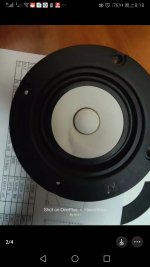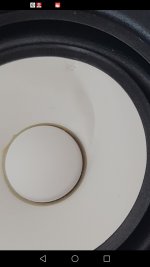At a glance, seems like if the 5.3 is good at 200, then adding another will drop it to 200*0.707 = ~141 Hz and roll the top one off to 'taste' with 350- 500 Hz (or somewhat higher if 1st order) being the traditional point.
Theoretically it's (Pluvia 7 PHD) available in our country too.
https://www.sonopart.com/spd/MAR-PL...udio-PLUVIA-7HD-Chrome-Full-range-Woofer-Soft
If the 8R versions are good for OP, wider variety of Markaudio is accessible.
https://www.sonopart.com/spd/MAR-PL...udio-PLUVIA-7HD-Chrome-Full-range-Woofer-Soft
If the 8R versions are good for OP, wider variety of Markaudio is accessible.
I do not have enough experience with Mark Audio drivers to recommend a particular model, but if you want to cross at 150Hz on an open baffle you'll require a 6" driver at the minimum, with healthy x-max. As others have mentioned, it comes down to the volume of air it can move vs the directionality of the driver and we all choose our own trade-offs.
but if you want to cross at 150Hz on an open baffle
And, if i remember MJK’s math right, would need a wide baffle since best XO is very baffle size dependent.
dave
Was posting while still at work. Definitely, there are many effects related to open baffle that can be mitigated with careful choice of driver/baffle size and crossover point, whether you're going for practically naked dipole or large open baffle if you can put the half wavelength pop and preceding dip in the crossover region you have a shot at dealing with them there. I'll have to check out what Martin has written about it, I primarily build very small to non existent baffle dipoles for home listening situations, in which the driver sizes are the critical factor and effects related to a baffle much larger than the driver are avoided. I have done some large open baffles for use in large commercial settings where SPL was the main factor, but I would not do it for critical listening.
The smaller the baffle in relation to the driver, the more you mitigate the negative effects of open baffle, but the sooner the low end roll off starts and the higher the boost required on the low end shelf and the more air you'll have to pump.
Personally, I would keep the 3" and cross it to an 8" or 10", both on small open baffles and cross them higher. Then cross those to the sub. The 3" - 8" dipole is a stellar combination and solves a lot of issues. I'm sure Martin has good info, he always has.
Jason
The smaller the baffle in relation to the driver, the more you mitigate the negative effects of open baffle, but the sooner the low end roll off starts and the higher the boost required on the low end shelf and the more air you'll have to pump.
Personally, I would keep the 3" and cross it to an 8" or 10", both on small open baffles and cross them higher. Then cross those to the sub. The 3" - 8" dipole is a stellar combination and solves a lot of issues. I'm sure Martin has good info, he always has.
Jason
Hi,
I think that the initial question goes into a wrong direction. Even if 5.3 driver is replaced by 10.3, not much will be achieved. What is needed, is at lest 12" bass driver in OB, (or better 15") and preserve the little 5.3 one on top.
Look at Manzanita for example.
Sub can be used to fill out some bottom notes if really felt necessary.
I think that the initial question goes into a wrong direction. Even if 5.3 driver is replaced by 10.3, not much will be achieved. What is needed, is at lest 12" bass driver in OB, (or better 15") and preserve the little 5.3 one on top.
Look at Manzanita for example.
Sub can be used to fill out some bottom notes if really felt necessary.
Yep, speaker building is all about trade offs, picking your poison and the rabbit hole goes very deep indeed.
Some prioritize polar radiation symmetry and stick with minimal baffle dipole radiators to avoid the ripple and lobing and these are generally more complex builds. Some will cross a 15" to a tweeter and are commercially successful, while others like Linkwitz and JohnK would never use a 15" due to directivity issues. Some enjoy a small full range on a very large baffle to help the bottom end, and some use a very large driver as a full range on a small baffle for an easy implementation.
Some would never cross to a single sub above 80hz and some would never try to use a dipole in the area below 60hz.
Some listen to electronic bass jams and some enjoy acoustic ensembles. Some listen close and some listen far. Some have a violin close to their ear for a couple hours every day, while others listen to death metal at the shooting range cranked to 110db with no ear protection.
Starting to feel a bit Dr Suess here. The point is we all have good, logical reasons to back up our preferences and no one is wrong. Until someone comes up with a 3/4" driver that can play 20hz to 20khz at 110db compromises will be made. And even then I'm sure the debates would stay lively.
Some prioritize polar radiation symmetry and stick with minimal baffle dipole radiators to avoid the ripple and lobing and these are generally more complex builds. Some will cross a 15" to a tweeter and are commercially successful, while others like Linkwitz and JohnK would never use a 15" due to directivity issues. Some enjoy a small full range on a very large baffle to help the bottom end, and some use a very large driver as a full range on a small baffle for an easy implementation.
Some would never cross to a single sub above 80hz and some would never try to use a dipole in the area below 60hz.
Some listen to electronic bass jams and some enjoy acoustic ensembles. Some listen close and some listen far. Some have a violin close to their ear for a couple hours every day, while others listen to death metal at the shooting range cranked to 110db with no ear protection.
Starting to feel a bit Dr Suess here. The point is we all have good, logical reasons to back up our preferences and no one is wrong. Until someone comes up with a 3/4" driver that can play 20hz to 20khz at 110db compromises will be made. And even then I'm sure the debates would stay lively.
Lots of helpful posts. Thank you for that. 🙂
I considered my possibilities:
1. Increase the baffle size
2. Increase the driver size
3. Use additional drivers under 300Hz
The second solution might be the less parctical since for the cost of a A10.3, a smaller bass-mid driver can be bought... And that solution might be better.
I think, in the first approach I will try to increase the baffles and will see (measure) how the driver behaves.
By the way, the drivers are still in burning-in phase, so I don't have to hurry to change anything.
I considered my possibilities:
1. Increase the baffle size
2. Increase the driver size
3. Use additional drivers under 300Hz
The second solution might be the less parctical since for the cost of a A10.3, a smaller bass-mid driver can be bought... And that solution might be better.
I think, in the first approach I will try to increase the baffles and will see (measure) how the driver behaves.
By the way, the drivers are still in burning-in phase, so I don't have to hurry to change anything.
What are those negative effects?The smaller the baffle in relation to the driver, the more you mitigate the negative effects of open baffle
Negative effects of an OB: a 6 dB/octave fall off below a frequency determined largely by bnaffle size (width), and you are getting a whole bunch of time delayed stuff off the backside), neither of which is solved with a smaller baffle.
dave
dave
...still the best sound, what I ever had. 😉...neither of which is solved with a smaller baffle
This sounds as the most reasonable soultion with good WAF.Personally, I would keep the 3" and cross it to an 8" or 10", both on small open baffles and cross them higher. Then cross those to the sub. The 3" - 8" dipole is a stellar combination and solves a lot of issues. I'm sure Martin has good info, he always has.
Hello Deka, sorry for the delayed response I've been extremely busy. Check out A3 on this page to see what happens to the radiation pattern as the baffle size increases in relation to the driver. Linkwitzlab models
Jason
Jason
I have always had really good luck using their numbers to design boxes.
I have also measured many hundreds of them and they have the tightest QC of any brand i have measured sufficient numbers to make a conclusion.
dave
I have also measured many hundreds of them and they have the tightest QC of any brand i have measured sufficient numbers to make a conclusion.
dave
Last edited:
Yesterday I rescued someone's damaged-cone MAOP 5 (gen1) and just listened to it box-less (back of driver wrapped) assisted by the Alpair 10.3 firing sideways out of a simple 10L. (The 4ohm 5 and 8ohm 10 are connected in series to favor the bass.) The dipole-bipole's combined response is basically flat 100-10khz, only a very small residual hump ~7.8khz from the 10 (mentioned in msg #16).In my limited experience with Markaudio, Alpair 5.3 has better HF and Alpair 10.3 has better LF. So I would suggest three possible extensions to your OB: (1) add 10.3 low-passed and/or not facing front; (2) another 5.3 push-pull or sealed; or (3) add wings and stuffing to make OB-U.
My total cost of the "five-and-dime" was only half of the MAOP 10 whose chart also showed the peak and may be NLA. All I had to do was un-deform the cone a little bit to stop the rubbing; passed my tone sweep comp listening test. Next I will get a real cab for the 10, likely a small TLonken, although the combo sounds pretty jaw-dropping as-is.
Attachments
Finally I decided to build something, like the Monacor Katana-M1 kit.
The only question is: Should I stay at the existing Mark Audio drivers or should I give a try to the Monacor SPX-31M drivers, what are used in the original design?
I can't find too much reviews about the Monacor drivers. Only lots of delighted Katana users posts.
I really like, what MA 5.3 drivers are producing... But the Monacor drivers arent expensive at all.
The only question is: Should I stay at the existing Mark Audio drivers or should I give a try to the Monacor SPX-31M drivers, what are used in the original design?
I can't find too much reviews about the Monacor drivers. Only lots of delighted Katana users posts.
I really like, what MA 5.3 drivers are producing... But the Monacor drivers arent expensive at all.
- Home
- Loudspeakers
- Full Range
- OpenBaffle with MarkAudio drivers

